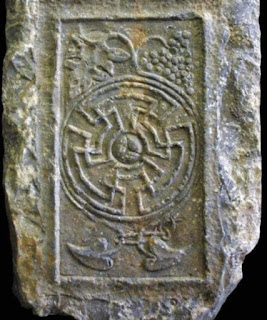Discovering Ancient Symbols: Unlocking the Secrets of Forgotten Albanian's Civilizations.
Introduction
Ancient symbols are more than just mysterious signs; they hold the keys to understanding forgotten cultures and civilizations. These enigmatic glyphs convey deep meanings, revealing the spiritual, philosophical, linguistic, and cosmological beliefs of our ancestors. From the intricate hieroglyphs of Egypt to the symbolic knotwork of the Illyrians, Celts, ancient symbols offer a window into the past, waiting to be deciphered.
The Dardanian Labyrinth: A Symbol of Cosmic Harmony
The Dardanian Labyrinth, discovered on an epigraphic monument in Smira, is an ancient symbol that embodies the religious and philosophical ideals of the Dardanian civilization.
This intricate emblem features:
- A closed circular maze, representing the cyclical nature of existence
- Grape motifs above, symbolizing abundance and fertility
- Larch leaves below, signifying protection and renewal
- A prophylactic node, safeguarding against negative energies
The central sphere represents the Sun, Light, and higher consciousness, reflecting the heliolatric beliefs of the Dardanians. The six swastikas surrounding the labyrinth illustrate the cycle of:
- Birth: emergence and potential
- Death: transformation and release
- Resurrection: rebirth and ascension
Unveiling the Albanian Roots
The Albanian language holds the key to understanding the Dardanian Labyrinth's symbolism. Related concepts include:
- Diell (sun): illumination and life
- Rreth (circle): unity and cyclical nature
- Radhë (row): order and harmony
- Gardhë (fence): protection and boundaries
- Rriskë (circle): renewal and cycles.
Introduction
Ancient symbols are more than just mysterious signs; they hold the keys to understanding forgotten cultures and civilizations. These enigmatic glyphs convey deep meanings, revealing the spiritual, philosophical, linguistic, and cosmological beliefs of our ancestors. From the intricate hieroglyphs of Egypt to the symbolic knotwork of the Illyrians, Celts, ancient symbols offer a window into the past, waiting to be deciphered.
The Dardanian Labyrinth: A Symbol of Cosmic Harmony
The Dardanian Labyrinth, discovered on an epigraphic monument in Smira, is an ancient symbol that embodies the religious and philosophical ideals of the Dardanian civilization.
This intricate emblem features:
- A closed circular maze, representing the cyclical nature of existence
- Grape motifs above, symbolizing abundance and fertility
- Larch leaves below, signifying protection and renewal
- A prophylactic node, safeguarding against negative energies
The central sphere represents the Sun, Light, and higher consciousness, reflecting the heliolatric beliefs of the Dardanians. The six swastikas surrounding the labyrinth illustrate the cycle of:
- Birth: emergence and potential
- Death: transformation and release
- Resurrection: rebirth and ascension
Unveiling the Albanian Roots
The Albanian language holds the key to understanding the Dardanian Labyrinth's symbolism. Related concepts include:
- Diell (sun): illumination and life
- Rreth (circle): unity and cyclical nature
- Radhë (row): order and harmony
- Gardhë (fence): protection and boundaries
- Rriskë (circle): renewal and cycles.
- Rris (to rear, bring up (children), to grow plants
to breed domesticated animals, to let over grow,
to increase)
- Vreshtë (vineyard): abundance and fertility
- Rush (grape): fruitfulness and prosperity
- Rro (to live, life): vitality and existence
- Mbyll (close): enclosure and safeguarding
- Mbro (protect): shielding and defense
- Hyn (enter): transition and passage
- Zan (catch): capture and understanding
Linguistic Legacy: Albanian's Impact on European Languages and non-Indo-European languages.
These Albanian roots have influenced various languages, including:
- Arabic: e.g., "rīš" (ریش) meaning "feather" or "border"
- Turkish: e.g., "rızık" (rizık) meaning "food" or "livelihood"
- Slavic languages: e.g., "ryad" (ряд) meaning "row" or "order"
- Greek (through Illyrian influences): e.g., "rhiza" (ῥίζα) meaning "root"
- Latin: e.g., "radius" meaning "radius" or "around"
- European languages: e.g., "radius," "circle," "row," "guard," etc.
The Albanian language verb 'rris' also resonates with:to breed domesticated animals, to let over grow,
to increase)
- Vreshtë (vineyard): abundance and fertility
- Rush (grape): fruitfulness and prosperity
- Rro (to live, life): vitality and existence
- Mbyll (close): enclosure and safeguarding
- Mbro (protect): shielding and defense
- Hyn (enter): transition and passage
- Zan (catch): capture and understanding
Linguistic Legacy: Albanian's Impact on European Languages and non-Indo-European languages.
These Albanian roots have influenced various languages, including:
- Arabic: e.g., "rīš" (ریش) meaning "feather" or "border"
- Turkish: e.g., "rızık" (rizık) meaning "food" or "livelihood"
- Slavic languages: e.g., "ryad" (ряд) meaning "row" or "order"
- Greek (through Illyrian influences): e.g., "rhiza" (ῥίζα) meaning "root"
- Latin: e.g., "radius" meaning "radius" or "around"
- European languages: e.g., "radius," "circle," "row," "guard," etc.
- English: "rear" (to bring up or grow)
- German: "erziehen" (to rear or educate)
- French: "élever" (to rear or raise)
- German: "erziehen" (to rear or educate)
- French: "élever" (to rear or raise)
Impact
Beyond the Albanian language, hundreds of grammatical units in languages derived from it relate to this symbol of the language-creating forefathers of the Albanians. This highlights Albanian's significance as a bridge language, connecting ancient civilizations and cultures.
Conclusion
The Dardanian Labyrinth and Albanian roots offer a fascinating glimpse into the symbolism and linguistic heritage of ancient civilizations. By deciphering these ancient symbols, we unlock the secrets of forgotten cultures and gain a deeper understanding of our shared human experience.
Beyond the Albanian language, hundreds of grammatical units in languages derived from it relate to this symbol of the language-creating forefathers of the Albanians. This highlights Albanian's significance as a bridge language, connecting ancient civilizations and cultures.
Conclusion
The Dardanian Labyrinth and Albanian roots offer a fascinating glimpse into the symbolism and linguistic heritage of ancient civilizations. By deciphering these ancient symbols, we unlock the secrets of forgotten cultures and gain a deeper understanding of our shared human experience.

Comments
Post a Comment